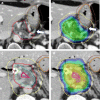Ablative radiation therapy for locally advanced pancreatic cancer: techniques and results
- PMID: 31171025
- PMCID: PMC6555709
- DOI: 10.1186/s13014-019-1309-x
Ablative radiation therapy for locally advanced pancreatic cancer: techniques and results
Abstract
Standard doses of conventionally fractionated radiation have had minimal to no impact on the survival duration of patients with locally advanced unresectable pancreatic cancer (LAPC). The use of low-dose stereotactic body radiation (SBRT) in 3- to 5-fractionshas thus far produced a modest improvement in median survival with minimal toxicity and shorter duration of treatment, but failed to produce a meaningful difference at 2 years and beyond. A much higher biologically effective dose (BED) is likely needed to achieve tumor ablation The challenge is the delivery of ablative doses near the very sensitive gastrointestinal tract. Advanced organ motion management, image guidance, and adaptive planning techniques enable delivery of ablative doses of radiation (> = 100Gy BED) when more protracted hypofractionated regimens or advanced image guidance and adaptive planning are used. This approach has resulted in encouraging improvements in survival in several studies. This review will summarize the evolution of the radiation technique over time from conventional to ablative and describe the practical aspects of delivering ablative doses near the GI tract using cone beam CT image (CBCT) guidance and online adaptive MRI guidance.
Keywords: Ablative radiation; CBCT guided radiation therapy; Hypofractionated ablative radiation; IGRT; MRI guided radiation therapy; Pancreatic adenocarcinoma.
Conflict of interest statement
PJP receives clinical trial funding from Viewray, Inc.; CHC and MR declare that they have no competing interests.
Figures


References
-
- Crane Christopher H., Varadhachary Gauri R., Yordy John S., Staerkel Gregg A., Javle Milind M., Safran Howard, Haque Waqar, Hobbs Bridgett D., Krishnan Sunil, Fleming Jason B., Das Prajnan, Lee Jeffrey E., Abbruzzese James L., Wolff Robert A. Phase II Trial of Cetuximab, Gemcitabine, and Oxaliplatin Followed by Chemoradiation With Cetuximab for Locally Advanced (T4) Pancreatic Adenocarcinoma: Correlation ofSmad4(Dpc4)Immunostaining With Pattern of Disease Progression. Journal of Clinical Oncology. 2011;29(22):3037–3043. doi: 10.1200/JCO.2010.33.8038. - DOI - PMC - PubMed
-
- Chauffert B, Mornex F, Bonnetain F, Rougier P, Mariette C, Bouche O, et al. Phase III trial comparing intensive induction chemoradiotherapy (60 Gy, infusional 5-FU and intermittent cisplatin) followed by maintenance gemcitabine with gemcitabine alone for locally advanced unresectable pancreatic cancer. Definitive results of the 2000-01 FFCD/SFRO study. Ann Oncol. 2008;19(9):1592–1599. doi: 10.1093/annonc/mdn281. - DOI - PubMed
Publication types
MeSH terms
Grants and funding
LinkOut - more resources
Full Text Sources
Other Literature Sources
Medical

